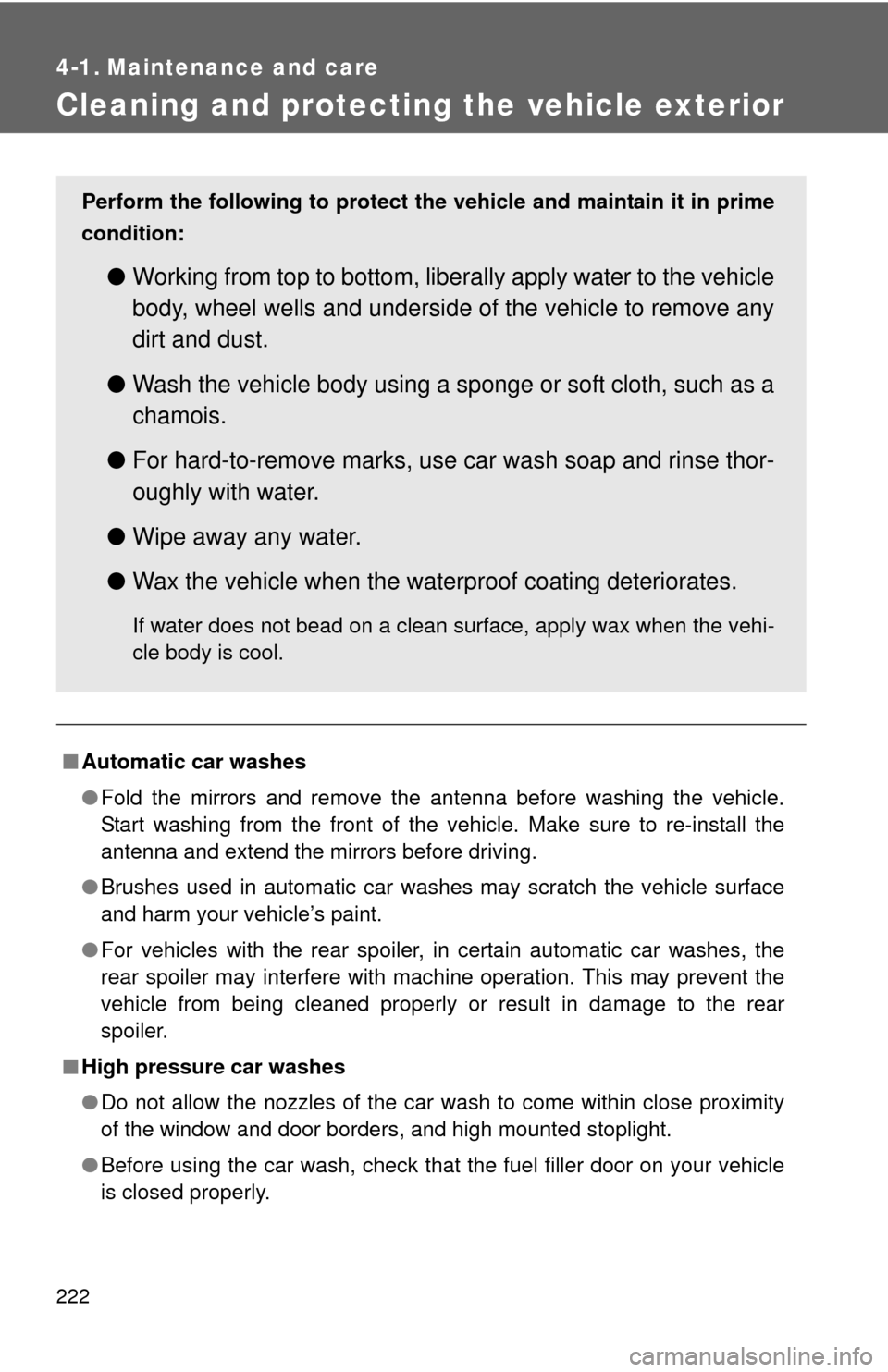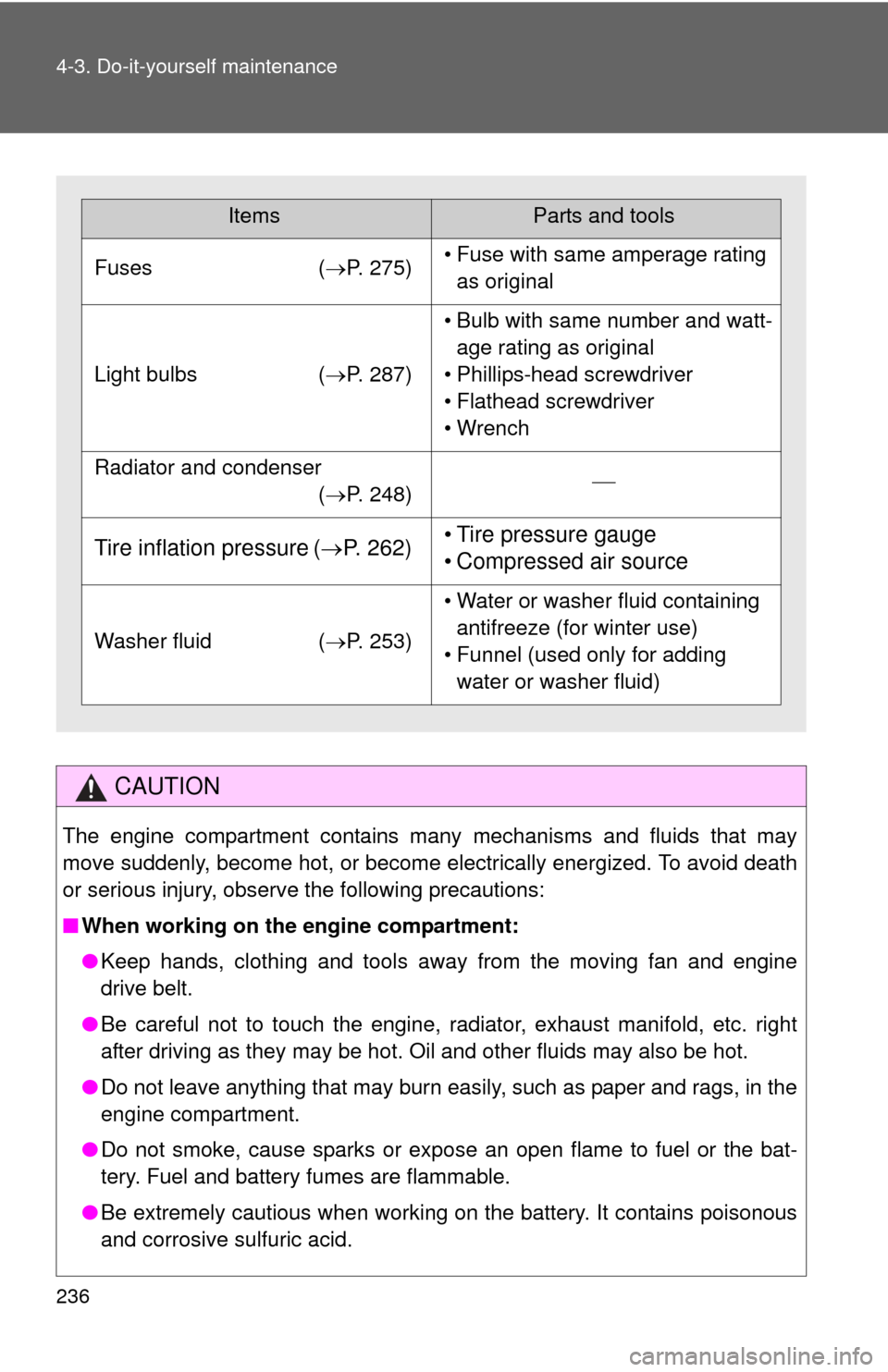Page 4 of 400

TABLE OF CONTENTSIndex
4
4-2. MaintenanceMaintenance requirements .................... 228
General maintenance ......... 230
Emission inspection and maintenance (I/M)
programs .......................... 234
4-3. Do-it-yourself maintenance Do-it-yourself service precautions ...................... 235
Hood................................... 238
Positioning a floor jack ....... 240
Engine compartment .......... 243
Tires ................................... 254
Tire inflation pressure......... 262
Wheels ............................... 266
Air conditioning filter ........... 269
Wireless remote control battery .............................. 271
Checking and replacing fuses ................................ 275
Light bulbs .......................... 287
5-1. Essential information Emergency flashers ........... 296
If your vehicle needs to be towed .......................... 297
If you think something is wrong ............................... 303
Fuel pump shut off system .............................. 304 5-2. Steps to take in an emergency
If a warning light turns on or a warning buzzer
sounds... .......................... 305
If you have a flat tire ........... 315
If the engine will not start .... 327
If the shift lever cannot be shifted from P (vehicles
with an automatic
transmission) .................... 328
If you lose your keys ........... 329
If the vehicle battery is discharged ........................ 330
If your vehicle overheats..... 334
If the vehicle becomes stuck ................................. 337
If your vehicle has to be stopped in
an emergency................... 339
6-1. Specifications Maintenance data (fuel, oil level, etc.) ........... 342
Fuel information .................. 353
Tire information................... 356
6-2. Customization Customizable features ........ 368
Items to initialize ................. 370
5When trouble arises
6Vehicle specifications
Page 7 of 400
7
Tires
●Rotation
● Replacement
● Inflation pressure
● Information
P. 254
P. 315
P. 262
P. 356
: If equipped
Back door P. 38
Side doors P. 34
Fuel filler door P. 69
Rear turn signal lights P. 130
Rear window defoggerP. 199
License plate lights P. 145
Stop/tail and rear side
marker lights
P. 145
Rear window wiperP. 153
Page 9 of 400
9
Tires
●Rotation
● Replacement
● Inflation pressure
● Information
P. 254
P. 315
P. 262
P. 356
: If equipped
Back door P. 38
Side doors P. 34
Fuel filler door P. 69
Rear window defoggerP. 199
License plate lights P. 145
Rear window wiperP. 153
Rear turn signal lights P. 130
Stop/tail and rear side
marker lights
P. 145
Page 15 of 400
15
Pictorial indexInstrument panel
SRS knee airbag P. 80
Hood lock release lever P. 238
Gauges and meters
Multi-information display P. 133
P. 140
Glove box P. 205
Fuel filler door opener P. 69
: If equipped
Tire pressure warning reset switch P. 255
AUX port/USB port P. 200
Power outlet P. 213
Page 222 of 400

222
4-1. Maintenance and care
Cleaning and protecting the vehicle exterior
■Automatic car washes
●Fold the mirrors and remove the antenna before washing the vehicle.
Start washing from the front of the vehicle. Make sure to re-install the
antenna and extend the mirrors before driving.
● Brushes used in automatic car washes may scratch the vehicle surface
and harm your vehicle’s paint.
● For vehicles with the rear spoiler, in certain automatic car washes, the
rear spoiler may interfere with machine operation. This may prevent the
vehicle from being cleaned properly or result in damage to the rear
spoiler.
■ High pressure car washes
●Do not allow the nozzles of the car wash to come within close proximity
of the window and door borders, and high mounted stoplight.
● Before using the car wash, check that the fuel filler door on your vehicle
is closed properly.
Perform the following to protect the vehicle and maintain it in prime
condition:
● Working from top to bottom, liber ally apply water to the vehicle
body, wheel wells and underside of the vehicle to remove any
dirt and dust.
● Wash the vehicle body using a sponge or soft cloth, such as a
chamois.
● For hard-to-remove marks, use car wash soap and rinse thor-
oughly with water.
● Wipe away any water.
● Wax the vehicle when the waterproof coating deteriorates.
If water does not bead on a clean surface, apply wax when the vehi-
cle body is cool.
Page 236 of 400

236 4-3. Do-it-yourself maintenance
CAUTION
The engine compartment contains many mechanisms and fluids that may
move suddenly, become hot, or become electrically energized. To avoid death
or serious injury, observe the following precautions:
■When working on the engine compartment:
● Keep hands, clothing and tools away from the moving fan and engine
drive belt.
● Be careful not to touch the engine, radiator, exhaust manifold, etc. right
after driving as they may be hot. Oil and other fluids may also be hot.
● Do not leave anything that may burn easily, such as paper and rags, in the
engine compartment.
● Do not smoke, cause sparks or expose an open flame to fuel or the bat-
tery. Fuel and battery fumes are flammable.
● Be extremely cautious when working on the battery. It contains poisonous
and corrosive sulfuric acid.
ItemsParts and tools
Fuses (P. 275)• Fuse with same amperage rating
as original
Light bulbs (P. 287)
• Bulb with same number and watt-
age rating as original
• Phillips-head screwdriver
• Flathead screwdriver
• Wrench
Radiator and condenser (P. 248)
Tire inflation pressure ( P. 262)• Tire pressure gauge
• Compressed air source
Washer fluid (P. 253)
• Water or washer fluid containing
antifreeze (for winter use)
• Funnel (used only for adding water or washer fluid)
Page 264 of 400

264 4-3. Do-it-yourself maintenance
■Tire inflation pressure check interval
You should check tire inflation pressure every two weeks, or at least
once a month.
Do not forget to check the spare.
■Effects of incorrect tire inflation pressure
Driving with incorrect tire inflation pressure ma y result in the following:
●Reduced fuel efficiency
●Reduced driving comfort and tire life
●Reduced safety
●Damage to the drive train
If a tire needs frequent inflating, have it checked by your Toyota dealer.
■Instructions for checking tire inflation pressure
When checking tire inflation pressure, observe the following:
●Check only when the tires are cold.
If your vehicle has been parked for at least 3 hours or has not been
driven for more than 1 mile or 1.5 km, you will get an accurate cold
tire inflation pressure reading.
●Always use a tire pressure gauge.
The appearance of the tire can be mi sleading. In addition, tire infla-
tion pressures that is even just a few pounds off can affect ride quality
and handling.
●Do not reduce tire inflation pressure after driving. It is normal for tire
inflation pressure to be higher after driving.
●Never exceed the vehicle capacity weight.
Passengers and luggage weight should be placed so that the vehicle
is balanced.
Page 284 of 400
284 4-3. Do-it-yourself maintenance
Under the driver’s side instrument panel
FuseAmpereCircuit
1 TAIL NO.2 10 A Parking lights, tail lights, license
plate lights, side marker lights
2 PANEL 5 A Gauges and meters, instrument
panel lights, switch illumination
3 DOOR R/R 20 A Power windows
4 DOOR P 20 A Power windows
5 ECU-IG NO.1 5 A Electric cooling fan, rear window
defogger, vehicle stability control
system, electric power steering sys-
tem, main body ECU, wireless
remote control system, tire pressure
warning system
6 ECU-IG NO.2 5 A Vehicle stability control system
7 A/C 7.5 A Air conditioning system, rear window
defogger, outside rear view mirror
defoggers
8 GAUGE 10 A Back-up lights, shift lock control sys-
tem, audio system, charging system,
multiport fuel injection system/
sequential multiport fuel injection
system
9 WASHER 15 A Windshield washer
10 WIPER 20 A Windshield wiper